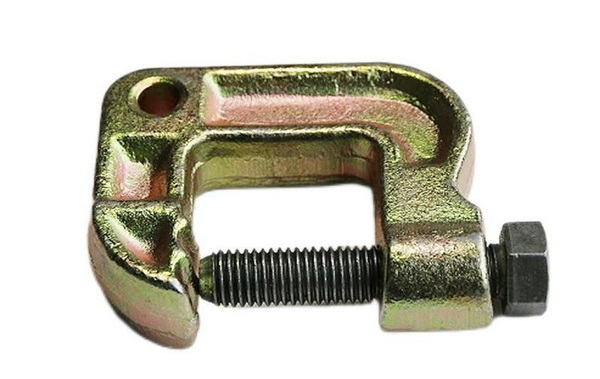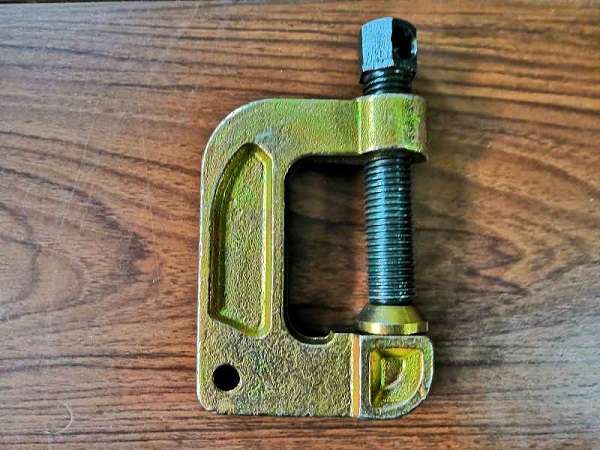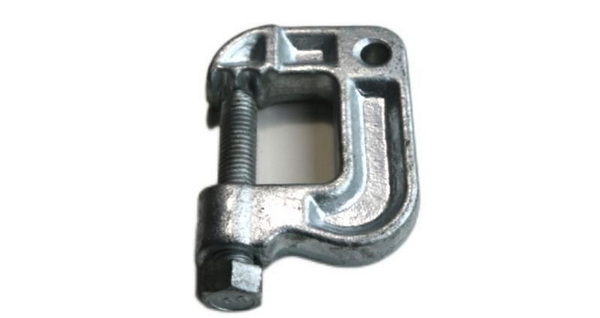Content Menu
● Understanding C Clamp Scaffolding
● Common Mistakes in C Clamp Scaffolding Usage
>> 1. Inadequate Planning and Risk Assessment
>> 2. Improper Assembly and Dismantling
>> 3. Overloading the Scaffolding
>> 4. Neglecting Regular Inspections
>> 5. Inadequate Fall Protection
>> 6. Using Damaged or Incompatible Components
>> 7. Improper Access and Egress
>> 8. Inadequate Training and Supervision
>> 9. Ignoring Environmental Factors
>> 10. Neglecting Proper Grounding
● Conclusion
● FAQ
>> 1. How often should c clamp scaffolding be inspected?
>> 2. What is the maximum load capacity for c clamp scaffolding?
>> 3. Can different brands of c clamp scaffolding components be mixed?
>> 4. What personal protective equipment (PPE) should be used when working on c clamp scaffolding?
>> 5. How can workers safely access c clamp scaffolding platforms?
● Citations:
C clamp scaffolding is a crucial component in construction and maintenance projects, providing temporary platforms for workers to perform tasks at height. However, improper use of c clamp scaffolding can lead to serious accidents and injuries. This article will explore the common mistakes made when using c clamp scaffolding and provide guidance on how to avoid them.

Understanding C Clamp Scaffolding
Before delving into the common mistakes, it's essential to understand what c clamp scaffolding is and its importance in construction work.
C clamp scaffolding, also known as tube and clamp scaffolding, is a versatile and widely used scaffolding system. It consists of steel tubes connected by specialized fittings called c clamps. This type of scaffolding is popular due to its flexibility, allowing for custom configurations to suit various project requirements.
Common Mistakes in C Clamp Scaffolding Usage
1. Inadequate Planning and Risk Assessment
One of the biggest mistakes in using c clamp scaffolding is failing to properly plan and assess risks before beginning construction[1]. This oversight can lead to unstable structures, inadequate safety measures, and increased likelihood of accidents.
To avoid this mistake:
- Conduct a thorough site survey
- Develop a detailed scaffolding plan
- Perform a comprehensive risk assessment
- Create a sound Method Statement
2. Improper Assembly and Dismantling
Incorrect assembly and dismantling of c clamp scaffolding can compromise its structural integrity, leading to collapses and falls[1]. This mistake often occurs due to lack of training or rushing to complete the job.
To prevent improper assembly:
- Ensure all workers are properly trained in c clamp scaffolding assembly
- Follow manufacturer's instructions meticulously
- Use the correct components and fittings
- Regularly inspect the structure during assembly and dismantling
3. Overloading the Scaffolding
Exceeding the weight capacity of c clamp scaffolding is a dangerous mistake that can result in structural failure[1]. This often happens when workers place too many materials or equipment on the platform.
To avoid overloading:
- Know and adhere to the scaffolding's weight limits
- Distribute loads evenly across the platform
- Remove unnecessary materials and equipment promptly
- Use material hoists for heavy loads when possible
4. Neglecting Regular Inspections
Failing to conduct regular inspections of c clamp scaffolding can allow small issues to develop into major safety hazards[1]. Wear and tear, environmental factors, and accidental damage can all compromise the scaffolding's integrity over time.
To ensure proper inspections:
- Implement a regular inspection schedule
- Train workers to identify potential issues
- Document all inspections and repairs
- Address any problems immediately

5. Inadequate Fall Protection
Neglecting proper fall protection measures is a critical mistake when using c clamp scaffolding[1]. This can include failing to install guardrails, not using personal fall arrest systems, or leaving gaps in the scaffolding.
To improve fall protection:
- Install proper guardrails on all open sides and ends
- Use personal fall arrest systems when necessary
- Ensure all platforms are fully planked or decked
- Cover or guard all holes and openings
6. Using Damaged or Incompatible Components
Using damaged, worn-out, or incompatible components in c clamp scaffolding can severely compromise its stability and safety[1]. This mistake often occurs when workers attempt to cut corners or when inventory management is poor.
To avoid this issue:
- Regularly inspect all scaffolding components
- Replace any damaged or worn parts immediately
- Use only compatible components from the same manufacturer
- Implement a robust inventory management system
7. Improper Access and Egress
Failing to provide safe and proper access to c clamp scaffolding platforms is a common mistake that can lead to falls and injuries[1]. This includes using makeshift ladders or climbing on the scaffolding structure itself.
To ensure proper access:
- Install proper ladders or stairways
- Secure access points to prevent unauthorized use
- Keep access areas clear of obstacles and debris
- Train workers on safe climbing procedures
8. Inadequate Training and Supervision
Insufficient training and supervision of workers using c clamp scaffolding is a critical mistake that can lead to numerous safety issues[1]. This can result in improper use of equipment, failure to follow safety procedures, and increased risk of accidents.
To improve training and supervision:
- Provide comprehensive training on c clamp scaffolding use and safety
- Ensure supervisors are knowledgeable and vigilant
- Regularly update training to reflect new safety standards
- Encourage a culture of safety among workers
9. Ignoring Environmental Factors
Failing to consider environmental factors when using c clamp scaffolding can lead to dangerous situations[1]. Wind, rain, snow, and extreme temperatures can all affect the stability and safety of the scaffolding.
To address environmental concerns:
- Monitor weather conditions regularly
- Implement additional safety measures during adverse weather
- Secure loose materials to prevent wind-related accidents
- Adjust work schedules to avoid extreme weather conditions
10. Neglecting Proper Grounding
Improper grounding of c clamp scaffolding, especially near electrical hazards, is a mistake that can lead to electrocution[1]. This is particularly important when working near power lines or using electrical equipment on the scaffolding.
To ensure proper grounding:
- Consult with electricians when working near electrical hazards
- Use proper grounding equipment
- Maintain safe distances from power lines
- Train workers on electrical safety procedures
Conclusion
Using c clamp scaffolding safely requires attention to detail, proper training, and a commitment to following safety procedures. By avoiding these common mistakes, construction teams can significantly reduce the risk of accidents and injuries associated with scaffolding use. Remember, safety should always be the top priority when working at height.

FAQ
1. How often should c clamp scaffolding be inspected?
C clamp scaffolding should be inspected before each use, after any modifications, and at regular intervals during prolonged use. A competent person should conduct a thorough inspection at least once a week.
2. What is the maximum load capacity for c clamp scaffolding?
The maximum load capacity varies depending on the specific scaffolding design and components used. Always refer to the manufacturer's specifications and never exceed the stated load limits.
3. Can different brands of c clamp scaffolding components be mixed?
It's generally not recommended to mix components from different manufacturers as they may not be compatible. Always use components from the same manufacturer to ensure proper fit and structural integrity.
4. What personal protective equipment (PPE) should be used when working on c clamp scaffolding?
Workers on c clamp scaffolding should wear hard hats, non-slip footwear, and fall protection equipment such as harnesses when required. Additional PPE may be necessary depending on the specific job tasks.
5. How can workers safely access c clamp scaffolding platforms?
Workers should use properly installed ladders or stairways to access scaffolding platforms. Climbing on the scaffolding structure itself should be avoided. All access points should be kept clear of obstacles and debris.
Citations:
[1] https://www.avontus.com/blog/five-common-scaffolding-mistakes-and-how-to-avoid-them/
[2] https://blog.csdn.net/weixin_40289064/article/details/79669930
[3] https://www.gcu.edu/blog/teaching-school-administration/mistakes-avoid-when-learning-scaffolding
[4] https://www.cambridgeinternational.org/Images/520575-june-2022-examiner-report.pdf
[5] https://www.flyability.com/blog/scaffolding
[6] https://www.ihsa.ca/rtf/health_safety_manual/pdfs/equipment/Scaffolds.pdf
[7] https://s3-ap-southeast-2.amazonaws.com/wh1.thewebconsole.com/wh/9048/images/STUDY-GUIDE_Scaffolding-Basic-to-Advanced-V1-0_11062019.pdf
[8] https://www.tdi.texas.gov/tips/safety/scaffolding.html






















